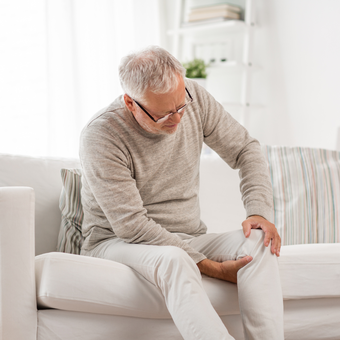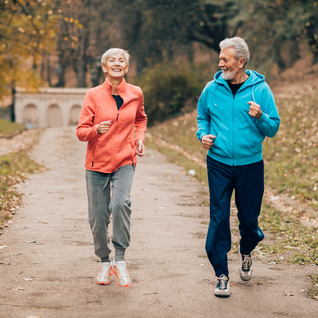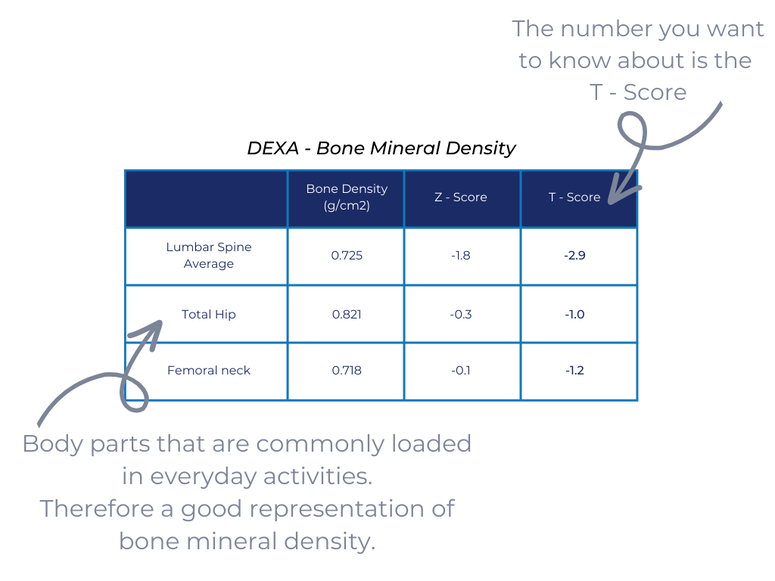|
Osteoarthritis is the most common form of arthritis in Australia. 1 in 5 people over the age of 45 will experience Osteoarthritis in one or more of their joints. While it most commonly affects the knee and hip joints it can be found in any joint throughout the body. It is not all bad news though, an ever-increasing body of research supports the use of exercise therapy as a treatment for Osteoarthritis. Exercise has been proven to help with both managing pain as well as improving function for people living with Osteoarthritis. (Skou et al., 2018) A common belief among those with Osteoarthritis, that we hear a lot at Simply Stronger, is that exercise or physical activity may cause more harm to their joint/s or make their osteoarthritis worse. This fear often leads people to become less active. It is important to understand that exercise will not progress your osteoarthritis or make it worse. In fact, being physically inactive is likely to cause more harm to our affected joints than being active. Inactivity can reduce the mobility and overall function of your joints, which can lead to more pain and less desire to be active. Pain can also play a big part for someone living with Osteoarthritis. We have been taught from a very young age that pain is bad, and that we should avoid pain. While that is an important lesson that has helped keep us all safe long enough to develop Osteoarthritis, avoiding osteoarthritis related pain has its limitations. It will likely feel counterintuitive, but it is ok to experience pain. When it comes to exercising with osteoarthritis sometimes, we will feel pain. The key is in understanding your pain and its limits. If the type of exercise is significantly increasing your pain, that’s when we should consider modifying or changing the type of exercise you are doing. This doesn’t mean that you stop exercising completely. All it means is that you consider changing the type of exercise or taking a few steps back with the exercise you are currently doing. However, what we have found is that if the type and amount of exercise you are doing isn’t increasing your pain, it is perfectly fine to continue with that form of exercise. Many of our clients living with Osteoarthritis have told us the pain and discomfort increased slowly over time, leading to gradual often unperceived reductions in movement and exercise. Not realising that moving less is actually causing more issues than staying active. The idea of getting started or increasing their exercise was a daunting one for many of them, so we were here to help with strategies to get started again. 4 strategies to help you get active with Osteoarthritis.Participate in exercise and activities you enjoy. We are more likely to participate in exercise if we are enjoying what we are doing. You will be more motivated to exercise if it is something that you are looking forward to. This could include not just the type of activity but who you do it with. Modify the exercise. If you find an exercise is increasing your pain it is time to modify it. This could mean a whole different activity or changing the activity you are doing. We refer to this as reducing the load of the exercise. This might involve decreasing weight or slowing down the pace at which you are working at. This way you are still moving, but in a more comfortable way. Take rest breaks. Rest breaks can be very handy when doing exercise. If you are experiencing a little more of a painful day, take longer rests between exercises. Seek support and advice If you find yourself unsure on where to start, that is where we as Exercise Physiologists come in. Working with an EP will allow you to ask any questions you have around your exercise prescription, pain and pain management, making you feel more comfortable with getting your body moving in a safe way. At Simply Stronger we have several ways you can use our services to help you be more active.
Skou, S., Klarlund Pedersen, B., Haxby Abbott, J ., Patterson, ., Barton, C. (2018). Physical Activity and Exercise Benefit More Than Just Symptoms and Impairments in People with Hip and Knee Osteoarthritis. Journal of Orthopaedic and Sports Physical Therapy, 48 (6), 439-447.
0 Comments
How do you check your bone health? The best way to check your bone health is by completing a bone mineral density scan (BMD). This is usually done by using a DEXA scan, a low-level x-ray to measure the strength of your bones. Once you have done this scan, you will get results that can be a little confusing when your first see them. Your results might look similar to the example below, where you will see a few different numbers, but we are going to focus on your T-Score. Now, let's get to understanding what this actually means to you. What is a T-Score? The T-Score is result that shows how many standard deviations your bone density is away from a healthy young adult (the difference between your bone mineral density and that of a healthy young adult). This means the more standard deviations away from a healthy young adult, the lower your bone strength and the more likely you are to have a fracture. As shown in the figure below, a score between +4 and -1 is considered normal, a score between -1 and -2.5 indicates low bone mass or Osteopenia, while a score of -2.5 or lower indicates Osteoporosis. For more information about osteoporosis and osteopenia check out our blog post Why your bones need strength training too! Which bones are tested and why? When having a BMD or DEXA scan completed a few locations are measured, your lumbar spine, hips and pelvis. These boney areas are know to be more dense as they take the more load and impact throughout your daily life, through activities such as walking. Where as areas like your wrist will naturally have a lower density as they do not have the same impact, unless you were to walk on your hands. The idea of limiting the scan to these more dense bones is that a diagnosis of Osteoporosis or Osteopenia in these more dense areas will in all likelihood mean the same in other less dense areas of your body. What now?
As you will know from our previous blog post 4.74 million Australians have been diagnosed with either Osteoporosis or Osteopenia, so the likelihood of your or someone you know developing it as you age is pretty high. So, now you're wondering what you can do about it. Seeing an Exercise Physiologist who can build you a customised exercise program that uses weight bearing and impact exercise to strengthen your bones and balance training to prevent falls is a great way to reduce your chances of developing Osteoporosis or Osteopenia as well as help those who have low bone density to reduce the impact it has on your life. To find out more email us at [email protected] or call 03 9964 3889, or you can book directly here. Alternatively you can follow our socials for more exercise and balance tips. Osteoporosis and Osteopenia are common conditions that revolve around bone density loss, making our bones more fragile and susceptible to fractures, but what does that really mean? Changes can occur within our bones that impacts their strength and health. This can be natural hormonal changes as we age, or heightened through ongoing and prolonged use of certain medications such as steroids, among others. The inside of healthy bones have a similar make up to that of a violet crumble chocolate bar, a spongey and honeycomb like structure. As our bones weaken, the "pockets" enlarge like larger air bubbles in the honeycomb, reducing the density of the boney structure and therefore the strength of our bones.
These conditions are often called the "silent disease" because they are typically asymptomatic until a fracture occurs. As I am sure you can imagine fractures can cause significant pain, reduced mobility, and decreased independence. It's crucial that we take steps to prevent and manage these conditions to keep us moving the way we want as we get older. So how do we prevent bone density loss from occurring? Exercise Exercise is an essential component of prevention and management, and there are many options available. Weight-bearing and impact exercises, like walking or jogging, are particularly beneficial as they can help to build and maintain our bone density. Resistance exercises can also be effective in improving bone density and our overall strength. While balance exercises are another integral component to reduce the risk of fractures by reducing the risk of falls in the first place.
One study by the Australian Institute of Health and Welfare found that only 44% of Australians aged 65 and over meet the recommended physical activity guidelines. We have talked about the guidelines in an earlier blog post, but incase you missed it here is a recap. We should all be aiming for a minimum of 150-300 minutes of aerobic exercise plus two resistance training sessions per week. The fact that only 44% of Australian meet this base level of activity is concerning because regular exercise is the best way for us to keep our bones and muscles strong and improve our balance and coordination, which can reduce the risk of falls and subsequent fractures. Not to mention, it's a great way to stay active and social. Osteoporosis and Osteopenia are serious conditions, but exercise plays a significant role in prevention and management. By staying active, we can help keep our bones strong and healthy, reduce our risk of fractures, and improve our overall quality of life. So, are you currently meeting the physical activity guidelines? Are you getting enough impact and weight bearing exercises into your daily life? Are your bones as healthy and strong as they could be? If the answer is no to any of these questions then it is time to consider what you are going to do about it. Simply Stronger is here to help. As experts in exercise prescription we can help tailor an exercise program that helps set you up for years to come, because your health is an investment worth making. Keep a look out on our socials in Facebook and Instagram for some great balance tips this April Falls Month as well as some more information around Osteoporosis and Osteopenia. Want to know more about how and Exercise Physiologist can help you reach our health goals, get in touch via email [email protected] or call us 03 9964 3889 or you can book directly here. |
AuthorSimply Stronger - here to make exercise simple. Understanding why you should exercise is a giant step towards wanting to exercise. Archives
April 2024
Categories
All
|







 RSS Feed
RSS Feed